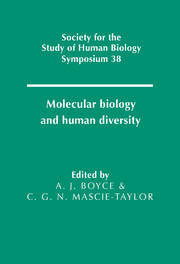Book contents
- Frontmatter
- Contents
- List of contributors
- Preface
- 1 Mitochondrial DNA in ancient and modern humans
- 2 Digital DNA typing of human paternal lineages
- 3 Minisatellites as tools for population genetic analysis
- 4 DNA fingerprinting: development of a technology and its application to the study of human populations
- 5 Kinship, inbreeding, and matching probabilities
- 6 Using the coalescent to interpret gene trees
- 7 Some attempts at measuring natural selection by malaria
- 8 AIDA: Geographical patterns of DNA diversity investigated by autocorrelation statistics
- 9 Mitochondrial DNA sequences in Europe: an insight into population history
- 10 Palaeolithic and neolithic contributions to the European mitochondrial gene pool
- 11 The molecular diversity of the Niokholo Mandenkalu from Eastern Senegal: an insight into West Africa genetic history
- 12 The peopling of Madagascar
- 13 Molecular perspectives on the colonisation of the Pacific
- 14 Population ancestry on Tristan da Cunha–the evidence of the individual
- 15 Linguistic divergence and genetic evolution: a molecular perspective from the New World
- 16 Allelic sequence diversity at the human β-globin locus
- 17 A nuclear perspective on human evolution
- 18 Contrasting gene trees and population trees of the evolution of modern humans
- 19 Methods and models for understanding human diversity
- Index
14 - Population ancestry on Tristan da Cunha–the evidence of the individual
Published online by Cambridge University Press: 19 September 2009
- Frontmatter
- Contents
- List of contributors
- Preface
- 1 Mitochondrial DNA in ancient and modern humans
- 2 Digital DNA typing of human paternal lineages
- 3 Minisatellites as tools for population genetic analysis
- 4 DNA fingerprinting: development of a technology and its application to the study of human populations
- 5 Kinship, inbreeding, and matching probabilities
- 6 Using the coalescent to interpret gene trees
- 7 Some attempts at measuring natural selection by malaria
- 8 AIDA: Geographical patterns of DNA diversity investigated by autocorrelation statistics
- 9 Mitochondrial DNA sequences in Europe: an insight into population history
- 10 Palaeolithic and neolithic contributions to the European mitochondrial gene pool
- 11 The molecular diversity of the Niokholo Mandenkalu from Eastern Senegal: an insight into West Africa genetic history
- 12 The peopling of Madagascar
- 13 Molecular perspectives on the colonisation of the Pacific
- 14 Population ancestry on Tristan da Cunha–the evidence of the individual
- 15 Linguistic divergence and genetic evolution: a molecular perspective from the New World
- 16 Allelic sequence diversity at the human β-globin locus
- 17 A nuclear perspective on human evolution
- 18 Contrasting gene trees and population trees of the evolution of modern humans
- 19 Methods and models for understanding human diversity
- Index
Summary
As with gene data, knowledge of frequencies of molecular variants from human population samples helps in tracing population affinities, histories, diversification. Other applications of practical interest are at the individual level, mostly in a forensic context for identification of individuals. In addition to these, however, knowledge of individual DNA constitution may help to illuminate the more remote genetic history of populations, to show where their genes come from. This is illustrated by the example of Tristan da Cunha. The data are from the full report by Soodyall et al. (1995).
The population of Tristan da Cunha, a small island in the middle of the south Atlantic ocean, dates from the arrival there of a British garrison in 1816. During the course of its history, 15 women (Table 14.1, column 1) brought genes to the population, excluding those transient individuals who were shipwrecked and stayed on the island for only a few weeks or months before they could resume their journeys. Many of these genes were lost from the population as the women or their descendants died or left the island (Roberts, 1968), so that to the nuclear gene pool of the population of today (December 31, 1994) only seven women have contributed (Table 14.1, column 3).
- Type
- Chapter
- Information
- Molecular Biology and Human Diversity , pp. 196 - 204Publisher: Cambridge University PressPrint publication year: 1996
- 2
- Cited by



